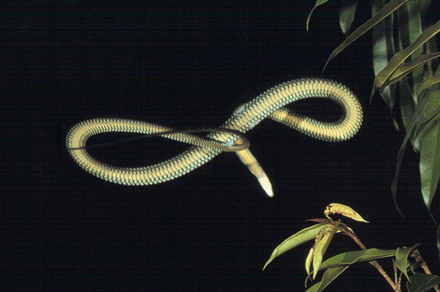What would make snakes scarier?
For spiders, the answer is easy. If you see one big enough to be feasting on Orc flesh in the caves under Mt. Doom, run, but snakes are tougher to make scary because they are slow.
Not all of them. Snakes may not look aerodynamic but some snakes can fly - literally. They slither in air, creating an S shape as they glide as much as 90 feet.
But how do they generate the lift to stay airborne? Jake Socha has spent much of his career figuring out flying snakes and says "They look like they are swimming. They turn their whole body into one aerodynamic surface."
According to Socha, the snakes flex their ribs as they launch to stretch and flatten the body to change their profile from a circle into an arched semi-circle. "It looks like someone's version of a UFO," laughs Socha, adding that as aerofoils go it's an unconventional shape.

Chrysopelea paradise. Photo credit: Jake Socha
To figure out the aerodynamic forces generated by the snake's body, Socha and colleagues Daniel Holden, Nicholas Cardwell and Pavlos Vlachos, used a 3D printer to produce a rod with the same UFO cross-section as the snake's body before placing it across a tank filled with water that flowed over the snake-shaped bar.
Socha explains that although water is much denser and stickier than air, you can precisely recreate the air conditions experienced as the snakes fly by flowing the water over the model at a specific range of speeds.
Tilting the snake model at angles of attack ranging from –10 to 60 degrees as the water flowed over it at speeds ranging from 20 to 50 cm/s, the team measured the lift and drag forces pulling on the model and saw that at most angles the animal's unusual body shape generated sufficient lift to account for some of the snake's impressive gliding performance.
But when the team tilted the model at 35 degrees, there was a massive spike in the lift generated by water flowing at higher speeds.
More surprisingly, when the model was held level with the flow, instead of generating upward lift, the fluid pushed the rod down. And when the team visualizsed the turbulent water flowing around the model with microscopic reflective beads, they could clearly see a spinning vortex sitting beneath the untilted snake shape, sucking it down: which may not be that crazy, according to Socha. "Maybe the snake does hold part of its body flat at some point, using it as a mechanism for control," explaining that twisting the body while airborne could allow the snakes to fine tune the forces on their bodies for precise flight control.
Socha adds that there is much more to the snake's impressive glide than just its unusual body shape. "If you make a rough estimate of the lift to drag ratio for the real animal, it appears to do better than what we got from this study. So even though this shape produced more lift than we were expecting, it doesn't get us the glide performance that snakes can attain, giving us a hint that there is something in what the animal is doing aerodynamically that is not captured by the cross-sectional shape alone" – which is the next part of the problem that Socha and his team hope to crack.
Citation: Holden, D., Socha, J. J., Cardwell, N. and Vlachos, P. P. (2014). Aerodynamics of the flying snake Chrysopelea paradisi: how a bluff body cross-sectional shape contributes to gliding performance. J. Exp. Biol. 217, 382-394 doi: 10.1242/jeb.090902






Comments